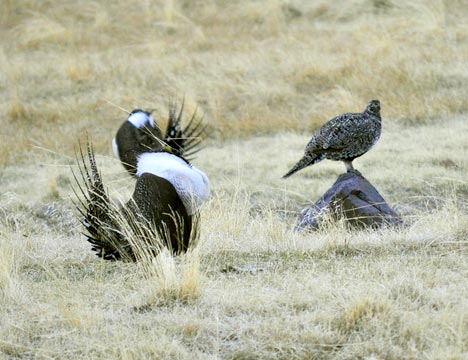-
Western Watersheds Project (the organization that I am the Executive Director of), WildEarth Guardians and the Center for Biological Diversity are fighting the reinstatement of grazing on four allotments in eastern Oregon that are permitted to Hammond Ranches. In part, we argue that the Hammonds don’t have a great track record and are thus undeserving…
-
Recently the Montana Department of Fish, Wildlife and Parks (MDFWP) Commission voted to permit cattle grazing on the Spotted Dog Wildlife Management Area (WMA). Approval of livestock grazing on the WMA is based on the theory that a quid pro quo allowing ranchers to graze their cattle on public land will reduce animosity towards wildlife…
-
This past December 2018 the Bureau Field office of the Bureau of Land Management (BLM) released a final Environmental Assessment for the Battle Creek, East Castle Creek, and Owens Allotments Grazing Permit Renewal, at least partially within the Little Jacks Creek Wilderness, part of the stunningly beautiful Owyhee Canyonlands Wilderness Complex in Idaho. The BLM…
-
The Oregon spotted frog was originally found throughout wetlands in Oregon and Washington. It is the most aquatic of all native frogs. It is always located near perennial water sources. Draining of these wetlands, livestock grazing, and dams have significantly reduced its habitat. For instance, 95% of the wetlands in the Willamette Valley and Klamath…
-
Across the West, livestock grazing is one of the most destructive land uses. Some 250 million acres of public lands are grazed by domestic livestock including those administered by the Forest Service and the Bureau of Land Management, as well as national wildlife refuges and even some national park units. This use is not benign.…
-
Rancher subsidy for using public grass reaches greatest amount allowed by law- News from Western Watersheds Project WASHINGTON―The U.S. Interior Department has reduced fees for grazing cattle and sheep on federal public lands to the minimum allowed under federal law, $1.35 an animal-month. Yesterday’s announcement applies to grazing in national forests and on public lands administered by…
-
The BLM just released its decision on its proposed Bruneau Owyhee Sage-grouse Habitat Project (BOSH Project) which will degrade 617,000 acres of southern Idaho by logging juniper, creating linear weed patches known as fire breaks, and using other questionable management strategies, all done, in the name of enhancing sage grouse habitat. Remarkably the BLM failed…
-
Newly approved vegetation “treatment” project is questionable, expensive News release. Western Watersheds Project BOISE, Idaho — Today, the Bureau of Land Management approved a plan to log off or tear out native juniper trees from 617,000 acres of public land in Idaho. The agency will cut, shred, and burn juniper trees under the guise of…
Dr. Ralph Maughan is professor emeritus of political science at Idaho State University. He was a Western Watersheds Project Board Member off and on for many years, and was also its President for several years. For a long time he produced Ralph Maughan’s Wolf Report. He was a founder of the Greater Yellowstone Coalition. He and Jackie Johnson Maughan wrote three editions of “Hiking Idaho.” He also wrote “Beyond the Tetons” and “Backpacking Wyoming’s Teton and Washakie Wilderness.” He created and is the administrator of The Wildlife News.
